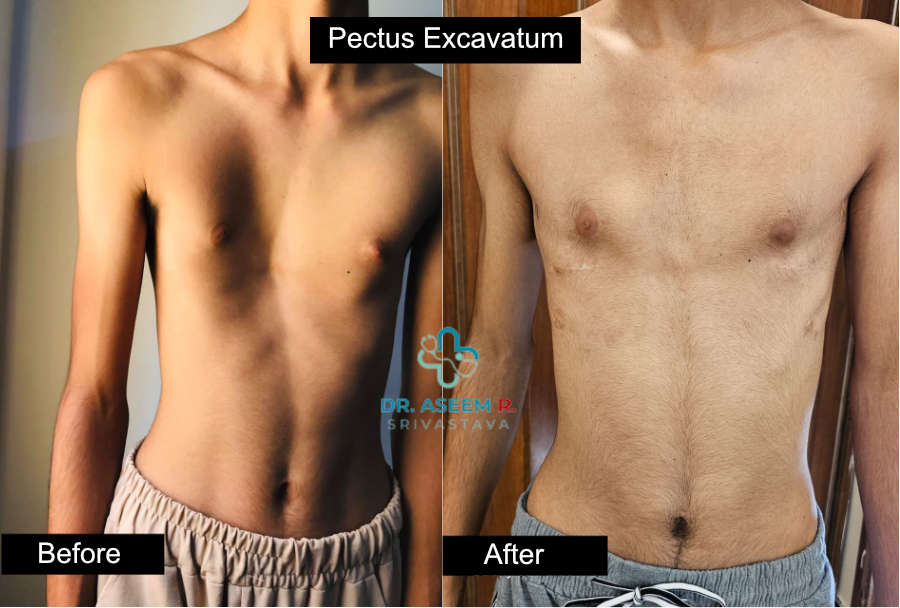What is Pectus Excavatum (Sunken Chest or Funnel chest)?
In pectus excavatum (funnel chest) the sternum (breastbone- the bone in the middle of the chest) is depressed inwards, and the chest can be unequal/ asymmetrical- leading to an appearance of pushed inwards at one place and pushed outwards on the other side.
The deformity varies in severity, ranging from a mild indentation/protrusion to severe, for example, a patient with a severe pectus excavatum may have only a few centimetres between his/her sternum and vertebral column. Severe cases of pectus excavatum can eventually interfere with the function of the heart and lungs. Most patients have a slim chest, a slouching posture and younger children commonly have potbellies.
The deformity is thought to be caused by excessive growth of the costal cartilages although the reason for this is unknown. This overgrowth causes the ribs and cartilages to ‘buckle’ and pushes the sternum either inwards or outwards.
This sunken chest will become more apparent during the period of rapid skeletal growth in early adolescence and symptoms can get worse- as the ribs push on the lungs and heart. After the age of about 18 years, the deformity remains stable.
The effects of Pectus excavatum can greatly affect a patient’s quality of life. Children around 10-15 years old may feel self-conscious about their appearance, they may also start to notice shortness of breath and having less athletic stamina than their friends.
Why do the surgery?
The primary aim of pectus excavatum surgery is to correct the chest deformity to improve a patient’s breathing, posture, and cardiac function. In addition – the correction of this deformity improves the child’s posture and improves self-esteem.
Surgical procedure- Nuss Operation
Surgery is usually done when the child is about 10-15 years old- however, it can be done earlier if the child’s deformity is severe or is causing significant respiratory and or cardiac compression.
Nuss Procedure is a minimally invasive operation to repair pectus excavatum. With the help of two small incisions on each side of the chest- a Steel/ Titanium bar which has been curved in the desired shape of the chest- is inserted under the sternum. And this bar pushes the breastbone outwards. The bar is then kept in position by fixing it to the ribs. The bar is not visible from the outside and stays in place for a two to three years. When it is time, the bar is removed. The surgery will take an average of four to six hours from start to finish.
Risks and benefits of the surgery
The benefit of the surgery is for the child to have a better posture and to remove compression on the lungs and heart.
Risks of surgery include bleeding, infection, long stay in the hospital. however, the total the risk of these occurring is 1 to 2 % or less.
What to expect during the hospital stay?
The length of the hospital stay usually varies from three to five days, and this will depend on how quickly the pain after surgery goes away. For a few days following surgery, we will take care of your child in the ICU. In the Intensive Care Unit, we will manage the pain after surgery, keep a watch on the child’s Heart Rate, Blood Pressure, Respiration, and other organ functions.
To avoid frequent interruptions in the care of your child, there is a restriction to visitors, however, parents can visit the child.
Going home : Discharge from Artemis Hospital, Gurgaon
The hospital will supply specific discharge instructions, medicine list and dosages and operation notes. All instructions from the hospital, cardiac surgeon should be strictly followed. The child should get back to his or her normal routine upon arrival at home. The child should be seen by us after 3-6 days of discharge from the hospital.

